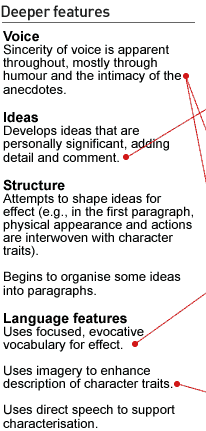


Matthew has worked hard to capture some quirky moments of his father's life and especially to depict his own relationship with his dad. He has used a mixture of observation, anecdotes, and humour to capture these moments. Together they form a sincere and loving picture of what appears to be a close bond.



The main goals of character writing are for students to:
• become aware that they can respond to characters, real or fictitious, in a unique, personal way
• be able to describe a character, either in a character sketch or a more complex character analysis.
The character exemplars demonstrate the progression from level 1i to level 5 as students pursue these purposes.
In promoting these purposes, most participating teachers used the following classroom approach.
They worked on character writing with their students over several sessions, depending on the class level. They began by exploring characterisation with the class through a range of familiar fictional characters. For this purpose, many teachers of junior students used picture books by authors such as Anthony Browne, Raymond Briggs, Beatrix Potter, Joy Cowley, Glenn Colquhoun, Patricia Grace, and Jenny Hessell. Teachers of older students often used extracts from works by authors such as Roald Dahl, J. K. Rowling, Patricia Grace, J. R. R. Tolkien, Katherine Mansfield, Witi Ihimaera, and Maurice Gee.
The teachers encouraged the students to consider how the authors portrayed selected characters' physical characteristics, actions, habitual behaviours, likes and dislikes, contexts and settings, and/or interactions with others. Much of this was through discussion and led to the students beginning to identify the elements of good character writing at their level. They focused especially on how the authors implied, rather than directly stating, the thoughts, feelings, and attitudes of a character. Teachers often encouraged the students to write their own descriptions of these fictitious characters as part of this exploration.
Most teachers then moved their students on to exploring real-life characters, usually someone who was personally meaningful to them. The teachers often initiated this exploration by sharing stories about their own "special person" with their students, usually a parent or grandparent, and then modelling how this character could be described.
For older students, this often took several shared writing sessions, with teachers focusing over time on their character's physical appearance, behaviour, thoughts or dialogue, personality traits, effect on others' lives, environment, and/or belongings.
This process further enhanced the students' understanding of what constituted good character writing, and led to their developing some shared criteria for character writing. These often included:
• providing some interesting details about the character, sometimes through anecdotes
• showing the reader some honest feelings about the character
• using precise and varied vocabulary, especially adjectives and verbs
• using language features that illustrated and supported the image of the character (for example, similes or dialogue).
To move Matthew towards the next learning step, the teacher could help him to focus on:
• Structure
• Vocabulary -using precise and varied verbs (for example, alternatives to "gets").
• Proofreading -checking for occasional spelling and punctuation errors.
The teacher could do this by:
• modelling the points that the students need to work on in group or individual learning sessions, which could include exploring examples of how other writers have managed them
• continuing to give Matthew specific feedback in conferencing times.